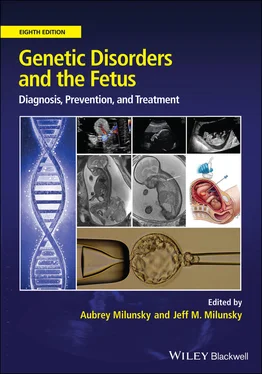Genetic Disorders and the Fetus
Здесь есть возможность читать онлайн «Genetic Disorders and the Fetus» — ознакомительный отрывок электронной книги совершенно бесплатно, а после прочтения отрывка купить полную версию. В некоторых случаях можно слушать аудио, скачать через торрент в формате fb2 и присутствует краткое содержание. Жанр: unrecognised, на английском языке. Описание произведения, (предисловие) а так же отзывы посетителей доступны на портале библиотеки ЛибКат.
- Название:Genetic Disorders and the Fetus
- Автор:
- Жанр:
- Год:неизвестен
- ISBN:нет данных
- Рейтинг книги:4 / 5. Голосов: 1
-
Избранное:Добавить в избранное
- Отзывы:
-
Ваша оценка:
- 80
- 1
- 2
- 3
- 4
- 5
Genetic Disorders and the Fetus: краткое содержание, описание и аннотация
Предлагаем к чтению аннотацию, описание, краткое содержание или предисловие (зависит от того, что написал сам автор книги «Genetic Disorders and the Fetus»). Если вы не нашли необходимую информацию о книге — напишите в комментариях, мы постараемся отыскать её.
Genetic Disorders and the Fetus — читать онлайн ознакомительный отрывок
Ниже представлен текст книги, разбитый по страницам. Система сохранения места последней прочитанной страницы, позволяет с удобством читать онлайн бесплатно книгу «Genetic Disorders and the Fetus», без необходимости каждый раз заново искать на чём Вы остановились. Поставьте закладку, и сможете в любой момент перейти на страницу, на которой закончили чтение.
Интервал:
Закладка:
Source: Yang et al. 2002. 131Reproduced with permission of Elsevier.
A 2009 Australian study found an overall survival figure for Down syndrome of 90 percent to at least 5 years of age. 132The known comorbidities of Down syndrome 116 , 133 – 149and earlier onset Alzheimer disease 133cast a longer shadow. In individuals with Down syndrome over 40 years of age, increasing neuropsychological dysfunction and loss of adaptive skills have been noted. 149Between 50 and 70 percent develop Alzheimer disease by 60 years of age, 139and up to 84 percent of those with dementia develop seizures. 136People with Down syndrome who are APOEε4 carriers and/or have multiple comorbid disorders are at an increased risk of both dementia and death. 150A French study between 1979 and 1999 found a sixfold decreased risk of death from urological cancer in those with Down syndrome. 146People with Down syndrome have an overall decreased incidence of solid tumors. 151
Table 1.3reflects the common associated defects and complications that occur in Down syndrome, some of which can be anticipated, monitored, prevented, and treated. 132 – 165A EUROCAT population‐based register study between 2000 and 2010 in 12 countries analyzed 7,044 livebirths and fetal deaths with Down syndrome. That report 152noted that 43.6 percent of births with Down syndrome had congenital heart disease while 15 percent had another congenital malformation. The National Society of Genetic Counselors published valuable guidelines for communicating both prenatal and postnatal diagnoses of Down syndrome. 166
Table 1.3 Defects and complications associated with Down syndrome 132 – 165.
| Defect or complication | Prevalence (percent) |
|---|---|
| Neurologic | |
| Intellectual disability | 100 |
| Hypotonia | 100 |
| Alzheimer disease and dementia | 68–80 |
| Sleep disorders | 65 |
| Autism | 7–16 |
| Hearing impairment | |
| Conductive | 84 |
| Sensorineural | 2.7 |
| Mixed | 7.8 |
| Epilepsy | 5–13 |
| Psychiatric disorders | 11–30 |
| ADHD | 34 |
| Moyamoya disease | 3.8 |
| Unexplained regression | Unknown |
| Heart | |
| Mitral valve prolapse | 57 |
| Congenital heart disease | 44 |
| Aortic valve regurgitation | 17 |
| Pulmonary hypertension | 1.2–5.2 |
| Respiratory | |
| Airway problems | >16 |
| Immune system | |
| Susceptibility to infection | 100 |
| Juvenile rheumatoid‐like arthritis | 1.2 |
| Gastrointestinal | |
| Congenital defects of the gastrointestinal tract | 6 |
| Celiac disease | 5.4 |
| Dysphagia | 55 |
| Endocrine/metabolic | |
| Overweight/obesity | 23–70 |
| Hypothyroidism | 50 |
| Diabetes mellitus | 1.4–10.6 |
| Hyperthyroidism | 1–3 |
| Ophthalmologic | |
| Eye disorders a | 80 |
| Cataract | 17–29 |
| Keratoconus | 8–10 |
| Hematologic/oncologic | |
| Leukemia | 2–3 (>20‐fold excess) |
| Testicular cancer | Standardized incidence ratio of 2.9 |
| Transient myeloproliferative disorder | <10 (20–30% risk of AML) |
| Retroperitoneal teratoma | Increased |
| Anemia | 2.6–10.5 |
| Musculoskeletal | |
| Atlantoaxial instability | 10–30 |
| Osteoarthritis/low bone density | 8–28 |
| Atlantoaxial subluxation | 1–2 |
| Dental | |
| Tooth agenesis | 54 |
| Orthodontic problems | ±all |
| Periodontal disease | ±all |
| Dermatologic | |
| Hidradenitis suppurativa | 2 |
| Dermatologic disorders | 1.9–39.2 |
| Urinary tract | |
| Urinary tract anomalies | 3.2 |
aIncludes strabismus, nystagmus, refractive errors, glaucoma, and lens opacities.
The goal and purpose of prenatal diagnosis
The fundamental philosophy of prenatal genetic diagnosis is to provide reassurance to couples at risk so that they may selectively have unaffected children even if their procreative risk for having offspring with a genetic disorder is unacceptably high. 167The goal is to reduce the risk of an adverse outcome to pregnancy and to secure the health of mother and fetus. Both the American Society for Reproductive Medicine and the American College of Obstetricians and Gynecologists recommend preconception counseling several times during a woman's reproductive lifespan. 168Fetal defects serious enough to warrant parental election of abortion are generally found in less than 5 percent of all cases studied, based on current indications for prenatal diagnosis. When couples are at risk for having a child with a serious or fatal disorder, common experience shows that those with risks between 10 and 25 percent or even greater most often avoid pregnancies unless prenatal diagnosis is available. The advent of prenatal diagnosis has made it possible for such high‐risk couples to have children that they would otherwise never have conceived. As a consequence, the number of children born because of prenatal diagnosis is much higher than the very small number of pregnancies terminated because of the detection of grave fetal defects. Prenatal genetic studies are used in Western society virtually exclusively for the detection of defects generally characterized by irreparable intellectual disability and/or irremediable serious to fatal genetic disease. Sadly, at present, the ideal goal of prevention or treatment, rather than abortion after prenatal detection of a fetal defect, is achieved only rarely, with the exception of NTDs. Preimplantation genetic testing (see Chapter 2) does, however, provide an important option that avoids abortion.
All couples or individuals concerned about the risks of genetic disorders in their offspring should seek genetic counseling before conceiving. For the more common indications for prenatal diagnosis (such as recognized carriers, a positive result on a noninvasive prenatal test [see Chapters 6– 8] or advanced maternal age), the well‐informed obstetrician should be able to provide the necessary information. 169 , 170However, a salutary observation in one study revealed that 43.3 percent of patients referred for amniocentesis exclusively for advanced maternal age had additional mostly unrecognized genetic risks, or significant concerns regarding one or more genetic or congenital disorders. 171Neither a questionnaire in the physician's office nor limited consultation time is likely to reveal many of these disorders. It is now vital that patients understand the importance of determining the name of a genetic disorder in the near or extended family. Since at least 6,739 monogenic phenotypes now have known genes, 2prenatal diagnosis or preimplantation genetic testing is available for avoidance or prevention.
Prerequisites for genetic counseling
Интервал:
Закладка:
Похожие книги на «Genetic Disorders and the Fetus»
Представляем Вашему вниманию похожие книги на «Genetic Disorders and the Fetus» списком для выбора. Мы отобрали схожую по названию и смыслу литературу в надежде предоставить читателям больше вариантов отыскать новые, интересные, ещё непрочитанные произведения.
Обсуждение, отзывы о книге «Genetic Disorders and the Fetus» и просто собственные мнения читателей. Оставьте ваши комментарии, напишите, что Вы думаете о произведении, его смысле или главных героях. Укажите что конкретно понравилось, а что нет, и почему Вы так считаете.












